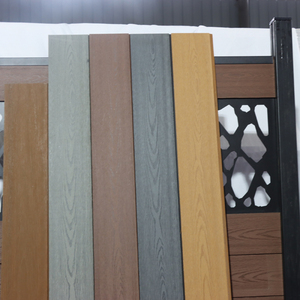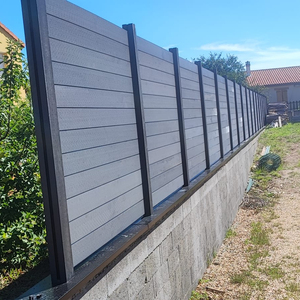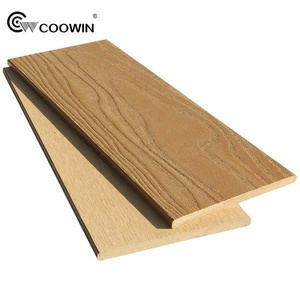
All categories
Featured selections
Trade Assurance
Buyer Central
Help Center
Get the app
Become a supplier

(26721 products available)





















































WPC garden fencing is a popular choice for homeowners looking to enhance their outdoor space. WPC, or wood-plastic composite, is a blend of wood fibers and plastic materials designed to provide the best of both worlds: the natural beauty of wood with the enhanced durability of plastic. Here's an overview of the key components of WPC garden fencing:
Material Composition:
WPC is made from a combination of recycled wood fibers, such as sawdust or wood shavings, and recycled plastic materials, like polyethylene or polypropylene. This mixture results in a strong composite material that doesn't warp, crack, or splinter like traditional wood can. The use of recycled content also means WPC is more eco-friendly than other fencing materials.
Durability and Longevity:
One of the main advantages of WPC garden fencing is its durability. Unlike conventional wood fences that can be damaged by pests, moisture, or extreme weather, WPC fences can withstand such conditions without losing their appearance or integrity. This makes WPC an ideal choice for areas with fluctuating climates or for homeowners who want a low-maintenance fencing option.
Aesthetic Appeal:
WPC fencing comes in a variety of colors and finishes, allowing homeowners to choose a style that complements their garden. Whether one prefers the classic look of stained wood or a more modern solid color, WPC can be manufactured to meet different aesthetic preferences. Moreover, the composite material doesn't fade easily, so the fence will maintain its color for years.
Environmental Benefits:
Since WPC is made from recycled wood and plastic, it helps reduce the amount of waste in landfills. Additionally, WPC doesn't require the same treatment processes as traditional wood (which often use harmful chemicals), making it better for the environment. By choosing WPC fencing, homeowners can contribute to protecting forests and reducing pollution.
Ease of Installation:
WPC garden fencing is easier to install than traditional wood fences. The lightweight material can be cut and assembled with standard tools, reducing the time and labor needed for installation. Many WPC fencing systems also have interlocking panels or pre-assembled sections, further simplifying the installation process.
Cost Considerations:
While WPC fencing may have a higher upfront cost than traditional wood, its long-term benefits can make it more economical. With almost no maintenance required, homeowners will save money on repairs and the need to replace the fence. Additionally, the durability of WPC means it can last 20-30 years or more, providing excellent value over its lifespan.
Board on Board:
In this design, two sets of fence panels are installed in an alternating manner. This means that one will alternate the boards by placing them on opposite sides of the support rail. This design is popular since it provides maximum privacy and security. Moreover, it is visually appealing, with a symmetrical look.
Horizontal Slatted:
This garden fencing design has horizontal slats attached to the fence posts and rails. The spacing between the slats can be customized for privacy. This design is modern and minimalist, easy to see and maintain. It provides a contemporary look to the garden.
Vertical Slatted:
This design is similar to the horizontal slatted, except that the slats are attached vertically to the posts and rails. It is a traditional style that is simple, practical, and easy to install. Vertical lines give the garden a classic and clean appearance.
Lattice Top:
A solid panel forms the lower part of this fence, while the upper part comprises a lattice panel. The lattice section allows for some visibility and airflow and adds an elegant touch.
Custom Cut Panels:
With WPC fencing, one can create custom-cut panels that fit unique spaces or shapes. This means that odd-shaped gardens or those with uneven terrain can still have the right fencing. Custom fencing is unique and practical.
Mix and Match:
One does not have to limit themselves to one design. Mixing and matching different designs gives the garden a creative and personal look. For example, one can combine horizontal slatted panels with lattice tops or customize cut panels with standard boards.
Residential homes:
WPC fencing is used in residential homes to provide privacy, security, and noise reduction. The fence can create a private space around the house, keep the garden area away from public view, and reduce the sound of outside traffic. The stylish design of these fences also makes them look great in residential landscaping.
Commercial properties:
On commercial properties, WPC fences are used to mark boundaries, provide privacy for business offices, and reduce noise from city streets. They can also be used to build attractive and durable fences around parks, shopping centers, and other commercial developments.
Public parks and recreational areas:
Public parks and recreational areas can use WPC garden fencing to create walking paths and gardens. These fences can serve as protective barriers around play areas for kids and pools, ensuring that only authorized persons enter these regions.
Institutional facilities:
In institutional facilities like hospitals or schools, WPC garden fencing can be used to create quiet healing gardens in hospitals where patients can relax away from the hustle and bustle of hospital activity. In contrast, schools can use them to separate different educational sections or outdoor learning spaces.
Agricultural settings:
Farmers may use WPC garden fencing to protect their crops from wildlife. Fencing can keep animals away from gardens and orchards, ensuring that fruits and vegetables are safe from being eaten by wild animals.
Urban landscaping projects:
Urban landscaping projects: WPC garden fencing works well in urban areas where space is limited but greenery needs to be introduced. These fences can demarcate community gardens or rooftop garden sections in densely populated areas.
Cooperative housing and gated communities:
These types of housing developments can use WPC garden fencing for their entrance gates and surrounding boundaries, providing security while adding an aesthetic appeal to the community.
Material composition:
It is better to choose a WPC fence made of 60% wood and 40% plastic. Such composition provides the best strength and durability. If a WPC fence has a wood content of 20% or less, it is mostly plastic and can be less durable. A good WPC fence should have at least 50% wood in the material composition.
Durability and warranty:
WPC fences are usually covered for 10 to 20 years, so when choosing a WPC fence, it is good to pick one with a longer warranty period. This means the manufacturer has more confidence in the product. Also, fences with lifetime warranties offer great value because the company stands behind its fence for a very long time.
Color and texture options:
WPC fences come in many colors and textures, so when choosing, people should pick one that matches their style. They should decide if they want a natural wood look, a modern matte finish, or even stone or tile patterns that WPC fences can imitate.
Ease of installation:
Some WPC fences are designed for easy homeowner installation. If people like to do things themselves, they should look for fences with interlocking panels or clip systems. Simple fences will save them money on installation costs. More complicated fences may require professional help to install them.
Maintenance requirements:
One of the advantages of WPC fences is their low maintenance compared to wood fences that need regular staining and sealing. People should check if the WPC fence comes with a protective coating that makes it even more water and stain-resistant. This extra layer can help the fence last even longer with little care.
Environmental impact:
WPC is made from recycled plastics and wood fibers, so when choosing a WPC fence, people should consider its environmental impact. Some WPC fences are designed to be more eco-friendly by using sustainable materials and manufacturing processes. Choosing a fence with a lower carbon footprint can be better for the environment.
Design and aesthetics:
People should consider the fence design and how it will look in their yard. They should choose a fence that will complement their landscaping and home style. WPC fences come in vertical and horizontal panel options, so people should pick one that fits their desired appearance.
Cost and budget:
Finally, people should consider the cost of the WPC fence and how it fits their budget. Remember to factor in the long-term savings from lower maintenance and potential energy efficiency benefits. Sometimes, spending a little more upfront for a higher-quality fence can save money in the long run.
Q1: Does WPC Garden Fencing need regular maintenance?
A1: WPC garden fencing needs little maintenance. It doesn’t need painting, staining, or sealing. Cleaning it occasionally is enough to remove dirt or debris.
Q2: Can WPC garden fencing be easily installed?
A2: WPC garden fencing is easy to install. It often comes with interlocking panels or post-mounted systems, and some suppliers supply a full installation video. It can be a cost-saving DIY project.
Q3: Is WPC garden fencing a sustainable option?
A3: WPC (Wood Plastic Composite) is a recycled material. It uses reclaimed wood and plastic to make products. This can reduce landfill waste. Also, many WPC brands are eco-friendly and obtain FSC certification, which indicates sustainable wood sourcing.
Q4: Does WPC garden fencing expand or contract with temperature changes?
A4: WPC fencing can expand or contract slightly with temperature changes. But, as mentioned above, a good-quality WPC garden fence will be made with materials that minimize this.
Q5: Is WPC garden fencing an economical choice?
A5: Although the upfront cost of WPC fencing may be slightly higher than traditional vinyl fencing, its durability, low maintenance, and long lifespan make it a cost-effective choice in the long run.